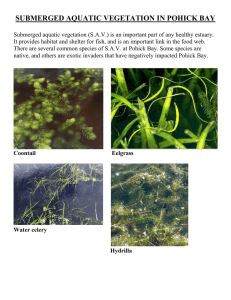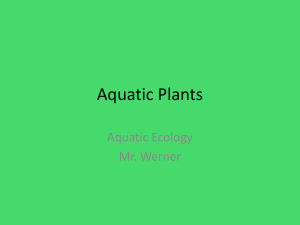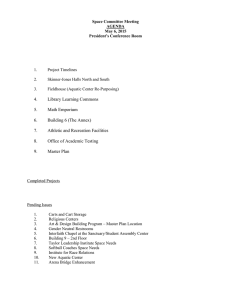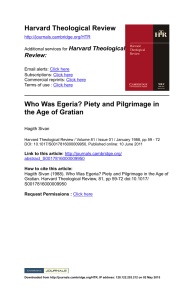MH MH MH MH MH H ML ML L H L
advertisement
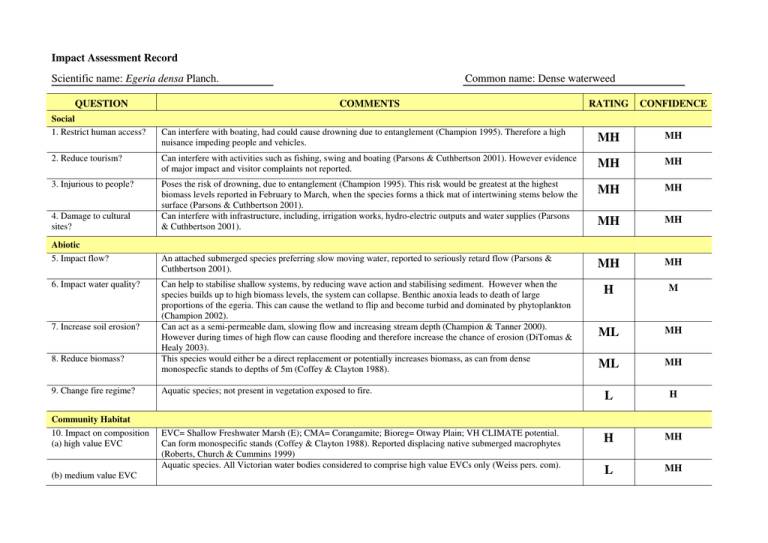
Impact Assessment Record Scientific name: Egeria densa Planch. QUESTION Common name: Dense waterweed RATING CONFIDENCE Can interfere with boating, had could cause drowning due to entanglement (Champion 1995). Therefore a high nuisance impeding people and vehicles. MH MH 2. Reduce tourism? Can interfere with activities such as fishing, swing and boating (Parsons & Cuthbertson 2001). However evidence of major impact and visitor complaints not reported. MH MH 3. Injurious to people? Poses the risk of drowning, due to entanglement (Champion 1995). This risk would be greatest at the highest biomass levels reported in February to March, when the species forms a thick mat of intertwining stems below the surface (Parsons & Cuthbertson 2001). Can interfere with infrastructure, including, irrigation works, hydro-electric outputs and water supplies (Parsons & Cuthbertson 2001). MH MH MH MH MH MH H M ML MH ML MH L H H MH L MH Social 1. Restrict human access? 4. Damage to cultural sites? Abiotic 5. Impact flow? 6. Impact water quality? 7. Increase soil erosion? 8. Reduce biomass? 9. Change fire regime? Community Habitat 10. Impact on composition (a) high value EVC (b) medium value EVC COMMENTS An attached submerged species preferring slow moving water, reported to seriously retard flow (Parsons & Cuthbertson 2001). Can help to stabilise shallow systems, by reducing wave action and stabilising sediment. However when the species builds up to high biomass levels, the system can collapse. Benthic anoxia leads to death of large proportions of the egeria. This can cause the wetland to flip and become turbid and dominated by phytoplankton (Champion 2002). Can act as a semi-permeable dam, slowing flow and increasing stream depth (Champion & Tanner 2000). However during times of high flow can cause flooding and therefore increase the chance of erosion (DiTomas & Healy 2003). This species would either be a direct replacement or potentially increases biomass, as can from dense monospecfic stands to depths of 5m (Coffey & Clayton 1988). Aquatic species; not present in vegetation exposed to fire. EVC= Shallow Freshwater Marsh (E); CMA= Corangamite; Bioreg= Otway Plain; VH CLIMATE potential. Can form monospecific stands (Coffey & Clayton 1988). Reported displacing native submerged macrophytes (Roberts, Church & Cummins 1999) Aquatic species. All Victorian water bodies considered to comprise high value EVCs only (Weiss pers. com). Impact Assessment Record Scientific name: Egeria densa Planch. QUESTION (c) low value EVC Common name: Dense waterweed COMMENTS Aquatic species. All Victorian water bodies considered to comprise high value EVCs only (Weiss pers. com). RATING CONFIDENCE L MH H MH 11. Impact on structure? Can form monosepcific stands (Coffey & Clayton 1988). Reported displacing native submerged macrophytes (Roberts, Church & Cummins 1999) 12. Effect on threatened flora? Has been reported to displace native submerged macrophytes (Roberts, Church & Cummins 1999). However no specific information on threatened species. MH M Fauna 13. Effect on threatened fauna? Reported to harbour different fish assemblages than those of native submerged macrophytes (Growns et al 2003). However no specific information on impact on threatened species. MH M 14. Effect on nonthreatened fauna? Reported to harbour different fish assemblages than those of native submerged macrophytes (Growns et al 2003). Therefore decrease in populations of some species with an increase in population of other species. MH MH 15. Benefits fauna? Provides a major food source for black swan (Cygnus atratus) (Champion 2002). Fish assemblages and invertebrate species are reported living amongst it, and can act as protection from predators (Duggan et al 2001; Growns et al 2003). Therefore it provides an abundant food source for at least one species and it creates a habitat and shelters various species. However unknown specifically for native species. No evidence of this reported. However it is reported to have potential to drown people through entanglement, it may therefore be able to drown animal species. ML MH M L L MH ML M L M L M L M 16. Injurious to fauna? Pest Animal 17. Food source to pests? 18. Provides harbour? There are exotic fish species reported to eat significant quantities of the species that they could be used for biocontrol measures, However they are not reported in Australia (Parsons & Cuthbertson 2001). Provides habitat for a fish assemblage (Growns et al 2003). Therefore could provide harbour for exotic fish species. Agriculture 19. Impact yield? Aquatic species, no evidence of this reported. 20. Impact quality? Aquatic species, no evidence of this reported. 21. Affect land value? Aquatic species, no evidence of this reported. Impact Assessment Record Scientific name: Egeria densa Planch. QUESTION Common name: Dense waterweed COMMENTS 22. Change land use? Aquatic species, no evidence of this reported. 23. Increase harvest costs? Can interfere with irrigation activities and block pumps, therefore increased maintenance costs (Parsons & Cuthbertson 2001). 24. Disease host/vector? Aquatic species, no evidence of this reported. RATING CONFIDENCE L M M MH L M
